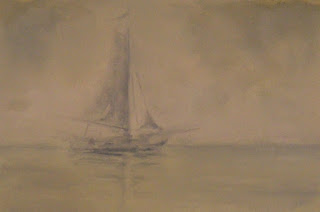We're putting the band back together.
Well, sort of.
My wife and I have started practicing with our friend Ann Fazzini, formerly of Magic City. We're currently learning a few covers and trying to figure out what kind of music the three of us can make. It's exciting and scary and a little bit giddy all at once. In that sense it's very much like the first months of dating, only with more people. This isn't unusual. It's how bands are supposed to start; the good ones anyway The bad ones hold auditions.
This post isn't about the band though. I learned long ago not to talk about my band. It's bad form, like talking about how rich you are or how drunk you were. No one cares. As a matter of fact, I'm such a stickler for not talking about my band that I actively discourage others from talking about my band as well. During my brief career in rock I became so adept at changing the subject that people would quickly forget they even asked me about my band.
Still, in spite of my best efforts, there's one question that can't be avoided. It is, of course, "What's the name of your band?"
Band names. So many band names. You could write a book on band names. In fact, Noel Hudson already has. It's called (not surprisingly)
The Band Name Book. The obvious premise is that band names are not chosen at random. They mean something. Barring that, they at least have a story behind them.
Given that the question is unavoidable, and given that I picked a potentially inscrutable name for our new project, I feel responsible for sharing its origin. For the record, this is the first, last and only time I'll do this.
The name of the band is The Christopher Rendition. Its origin lies in the laziest and most cynical of all current band name conventions; linking two incongruous words or phrases by use of a homonym or homograph.
This particular type of band name is most often arrived at by taking a proper noun and appending to it some unrelated word or syllable, thereby creating a (presumably) clever or ironic phrase (see The Brian Jonestown Massacre, Scott Beowulf, Mary Tyler Morphine, Camper Van Beethoven, JFKFC, etc.).
In our case, it started with England's most famous architect, Christopher Wren. My wife and I had taken a trip to London and I'd been thinking a lot about the architect and his work. I was also thinking about band names, homonyms, and coming up with some suitable moniker for a band that didn't actually exist at the time (Sometimes the name comes first.). At some point the name Christopher Rendition popped into my head. I liked the sound of it. It struck me as both fictive and plausible all at once. It was made up, but also weirdly authentic. That rendition has come to mean something clandestine and covert in today's vernacular added an element of threat to it.
Christopher Rendition wasn't enough though, so I thought, "What about adding "The"?", "What about The Christopher Rendition?". Well that changed the tenor completely. It took the name out of the realm of ironic homonyms and placed it somewhere altogether different. Let me explain.
If you're a student of Hollywood film naming conventions, particularly those popularized in the 60s and 70s, then you instantly recognize the formula THE + PROPER NOUN + COMMON NOUN = FILM TITLE. That era is littered with movie titles following that exact prescription:
The Thomas Crown Affair
The Parallax View
The China Syndrome
The Poseidon Adventure
The Wilby Conspiracy
The Odessa File
The Andromeda Strain
The French Connection
The Italian Job
The Christopher Rendition, it seemed to me, would have fit perfectly among those antiquated titles. I was struck by how easily it could pass for some now forgotten thriller starring Michael Caine and Harry Andrews. I even had a backstory for it; a mob hit goes bad, the wrong guy gets killed. Michael Caine seeks revenge by enlisting the aid of a soon to be retired police inspector. At some point it dawned on me that I could probably just tell people it
was the name of a 1972 Michael Caine film. I doubt anyone would have been the wiser. It just rings that true.
So where does that leave us in the world of band names? In short, we're a band named after a fictitious movie.
This puts us in some interesting conceptual territory. The history of rock offers plenty of bands named after films. Pulp, Fine Young Cannibals, Mudhoney, Alphaville, and They Might Be Giants come to mind. There's probably more. To my knowledge though we might be the first band named after a movie that's never been made. Who knows, maybe someday someone will make it. It really is a good title.































